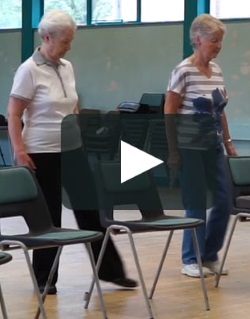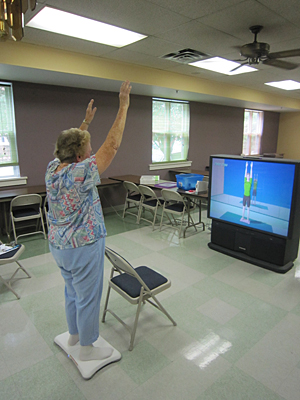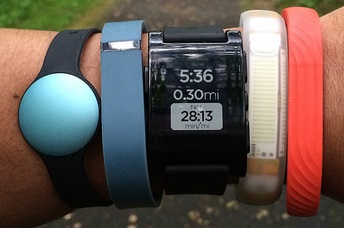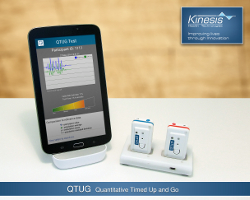Two older women from my community have had falls in the last month – one resulting in a broken arm, the second no lasting injury this time, but previously she has broken both hips due to falls. I enquired about how she had found fall prevention classes and was amazed that she’d never heard of them despite the wealth of evidence that falls can have long-lasting negative consequences for confidence, mobility and wellbeing, and fall prevention is well researched.
A few minutes of web-searching highlighted a number of great articles about fall prevention from AgeUK and the NHS in the UK, and US-based NIH and the Mayo Clinic, which are well worth a read. In summary, the top preventative measures are:

- Strengthen your muscles and balance – more on this below.
- Get comfortable – if your feet or other part of your body hurt when you move then this will affect the way you move and your balance, so wear comfortable well-fitting shoes and treat your feet with a bit of love; get painful problems (ingrowing toe nails, bunions etc) seen to sooner rather than later.
- Keep a clear head – be extra careful if you suffer dizziness when getting up – this may be caused by medication, hot weather or underlying ailments.
- Tidy Up – make sure routes about your home and garden are clutter free with no trip hazards, including fraying carpets and rugs. Get help with this if you need it.
- Light up and look out – ensure that you can see clearly as you move about. Get your eyes tested, wear the right glasses and use high power lamps so your path is adequately lit.
- Don’t sweat the steps – avoid carrying heavy or bulky items up or down stairs. Test the weight of something, by tilting it before you lift it to avoid carrying anything that is too heavy for you, and when you do pick something up use safe lifting practises
There has been a lot of research on what sort of balance and strengthening exercises work best and which do not. So while brisk walking is recommended for general fitness / muscle strengthening, it is not recommended if you have balance issues as it can increase the risk of falls (Sherrington et al., 2011). The booklet here and NHS pages show a range of exercises for balance and strength but the most effective regimes involve 45-75 minute sessions of mixed exercises several times a week for over 6 months, first led by a trained professional and then reliant on individuals to continue. Effective strengthening isn’t just about what exercises are performed, but their intensity and duration. In a study of preventative exercise services by the Royal Colledge of Physicians, while most included the correct types of exercise, most did not sustain the exercise over a long enough period (6 months minimum) or provide exercise of sufficient intensity (including use of ankle and wrist weights) which compromised the effectiveness of the classes. The duration and intensity required also demand quite a commitment from the individuals themselves, and I can imagine that sitting back and resigning oneself to a little more time on the sofa is a tempting alternative. Can technology help people maintain the commitment needed to significantly reduce their risk of falling?
Technology for Strength and Balance Exercise Motivation
The idea behind health apps and activity trackers in general is that monitoring one’s behaviour and getting feedback (eg against a goal) can help change behaviour and motivate people to attain goals that they would otherwise lose interest in. This sounds like just the thing to help. While there are a few smart-phone apps that claim to support fall prevention, the top listed apps for fall prevention do not seem to use the phones’ motion sensors, all had less than 500 downloads, and most hadn’t been updated for some time, so cannot be recommended, although I have downloaded one that mentioned Otago excercises (mentioned above) to take a closer look. There are many general stretching and exercise apps but none related to the FaME and Otago exercise programmes which are clinically proven to support fall prevention, and none seemed geared towards older people. However, Tai Chi exercise is also linked to fall prevention and there are many apps that claim to help to support Tai Chi training, but the apps focused on providing videos of the excercise intended but not tracking and recording actual exercise through the phone motion sensor.

Although the Wii Fit is old one of the excercise games it comes with is based on the moves of another martial art, Kung-Fu and another on Yoga. A lot of research has been carried out relating to Wii Fit use in a health care scenario, unfortunately, the results varied and no definitive conclusion on effectiveness was reached, partly because there was no consistency in the goals of the various studies or the way they were run. Some people seemed to love it, others not. Some used it at home, others as part of an exercise class. One study in two different countries found acceptance seemed related to the setting (one class was in a clinic, not many liked it; the other a fun community-based class where it was positively received) but they couldn’t prove the outcomes depended on the class setting rather than other factors, so the research was inconclusive. For personal use it may be worth trying a Wii Fit to see if the experience is fun and motivating and sticking with it if it works for you.

Wrist-worn devices are among the best-known activity trackers, all measure the number of steps taken, some also measure heart rate, so could these be used? Consumer devices like the Fitbit in the link above are highly focussed on their core role of recording steps, so filter out other movements very effectively. As fall prevention exercise regimes involve a range of movements with only a few stepping ones, they are not likely to record much of the activity. The excercises are suposed to be intense so the activity might be enough for heart rate monitors to register that someone is performing their exercise-based prevention plan and use that to record progress towards the long term goal.

There are specialist movement trackers, such as Kinesis Health Technologies which are designed to measure very detailed movement. These are intended to identify people most at risk of falling before they fall by accurately and consistently recording a standard mobility test (a type of Timed Up and Go test ). This early identification allows preventative interventions to be targeted. Although the technology used could be modified to support training it is currently only aimed at health care professionals. Another company looking to use technology to prevent falls is Walk With Path. Their Path Finder device is aimed at people with a condition known as Freezing of Gait (FoG), common for those living with Parkinson’s disease.

This provides a visual cue to the wearer on where to step next, so is not suitable for recording exercise progress. Various smart-insoles have been proposed in recent years which are intended to identify those at risk of falling, but none have yet made it out of the lab.
In the case of fall prevention, it seems that there is technology can be used by professionals and it holds promise for a motivated individual to assist with recording their exercise regime. However, the solutions for individuals are not tailored to helping someone maintain a sustained period of clinically proven muscle-and balance-strengthening exercises so it will be some time before Fitbit, Jawbone or Nintendo devices are provided to help people sustain their motivation to build up their strength and balance over a prolonged period.
—
Photo credits: All photos are owned by the entities linked to from the photos, except fitness trackers, Mike Lee Creative Commons and title image derived from Pixabay.
